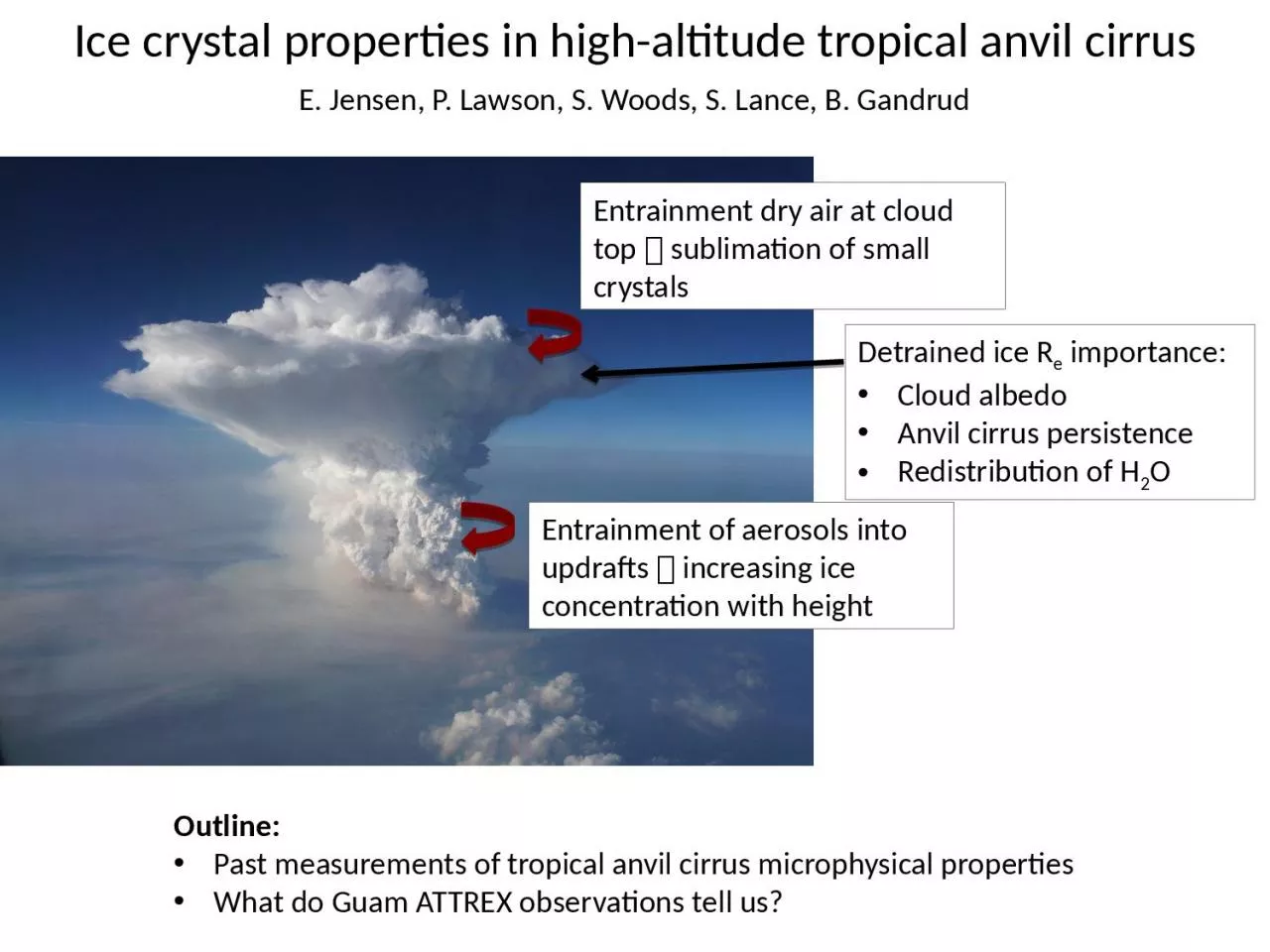

Detrained ice R e importance Cloud albedo Anvil cirrus persistence Redistribution of H 2 O Entrainment of aerosols into updrafts increasing ice concentration with height Entrainment dry air at cloud top ID: 914650
Download Presentation The PPT/PDF document "Ice crystal properties in high-altitude ..." is the property of its rightful owner. Permission is granted to download and print the materials on this web site for personal, non-commercial use only, and to display it on your personal computer provided you do not modify the materials and that you retain all copyright notices contained in the materials. By downloading content from our website, you accept the terms of this agreement.
Slide1
Ice crystal properties in high-altitude tropical anvil cirrus
Detrained ice R
e
importance:Cloud albedoAnvil cirrus persistenceRedistribution of H2O
Entrainment of aerosols into updrafts
increasing ice concentration with height
Entrainment dry air at cloud top
sublimation of small crystals
Outline:Past measurements of tropical anvil cirrus microphysical propertiesWhat do Guam ATTREX observations tell us?
E. Jensen, P. Lawson, S. Woods, S. Lance, B.
Gandrud
Slide2STEP ER-2 (Darwin, 1987)
Knollenberg et al. (JGR, 1993):
Extremely high ice concentrations (10–100 cm
-3)Modified 2D optical-array probe to mimic FSSP (accuracy difficult to assess)
Slide3Geophysica campaigns
APE THESEO (1999), Scout-O
3 (2005), TROCCINOX (2005), SCOUT-AMMA (2006)Ice concentrations in cold anvil cirrus up to 1 cm-3
(Krämer et al., 2009); higher concentrations in fresh MCS outflow (Frey et al., 2011)Mostly FSSP only (+CIP on AMMA): shattering artifacts in anvil cirrus likely, crystals larger than 25–50 μm not measured
Not very useful for anvil cirrus
Hector samplingEMERALD-II (2003),
TWP-ICE (2006)Grob 520T Egrett
(up to ~14.5 km), CPI and FSSP (Connolly et al., 2005)Proteus (up to ~16 km), FSSP, CDP, CIP (McFarquhar et al., 2007)
Slide4TC4 DC-8 (E
astPac, 2007)
2D-S with shattering artifacts removedNo higher than 12–13 km (sub-TTL)
Mature anvil ice concentrations ~0.1 cm-3Up to 10 cm-3 in updraft cores at 12 km
depletion by dilution and sublimation
Information lacking for TTL anvil cirrus!
Slide54–5 March Global Hawk flight (RF03)
Slide64–5 March Global Hawk flight (RF03)
Slide74–5 March Global Hawk flight (RF03)
Slide84–5 March Global Hawk flight (RF03)
Slide94–5 March Global Hawk flight (RF03)
Slide104–5 March Global Hawk flight (RF03)
Slide114–5 March Global Hawk flight (RF03)
Slide124–5 March Global Hawk flight (RF03)
Slide134–5 March Global Hawk flight (RF03)
Slide144–5 March Global Hawk flight (RF03)
Slide154–5 March Global Hawk flight (RF03)
Slide164–5 March Global Hawk flight (RF03)
Slide174–5 March Global Hawk flight (RF03)
Slide184–5 March Global Hawk flight (RF03)
Slide194–5 March Global Hawk flight (RF03)
Slide204–5 March Global Hawk flight (RF03)
Slide214–5 March Global Hawk flight (RF03)
Slide224–5 March Global Hawk flight (RF03)
Slide234–5 March Global Hawk flight (RF03)
Vertical profile through
Faxai cirrus band on GH climbout from Guam
Slide244–5 March Global Hawk flight (RF03)
Slide254–5 March Global Hawk flight (RF03)
Slide264–5 March Global Hawk flight (RF03)
Slide274–5 March Global Hawk flight (RF03)
Slide284–5 March Global Hawk flight (RF03)
Slide294–5 March Global Hawk flight (RF03)
Slide304–5 March Global Hawk flight (RF03)
Cirrus band sampled just south of
Faxai
Slide314–5 March Global Hawk flight (RF03)
Slide324–5 March Global Hawk flight (RF03)
Slide334–5 March Global Hawk flight (RF03)
Slide344–5 March Global Hawk flight (RF03)
Slide35March 4-5
climbout
through cirrus
Aggregates and rosettes near cloud base
Slide36March 4-5
climbout
through cirrus
Aggregates and rosettes near cloud base
Slide37March 4-5
climbout
through cirrus
Slide38March 4-5
climbout
through cirrus
Slide39March 4-5
climbout
through cirrus
Rosettes and small crystals at intermediate altitudes
Slide40March 4-5
climbout
through cirrus
Slide41March 4-5
climbout
through cirrus
Slide42March 4-5
climbout
through cirrus
Slide43March 4-5
climbout
through cirrus
Slide44March 4-5
climbout
through cirrus
Slide45March 4-5
climbout
through cirrus
Slide46March 4-5
climbout
through cirrus
Only small crystals near cloud top
Slide47March 4-5
climbout
through cirrus
Slide48March 4-5
climbout
through cirrus
Slide49March 4-5
climbout
through cirrus
Slide50March 4-5
climbout
through cirrus
Slide51March 4-5 closest approach to
Faxai
Slide52March 4-5 closest approach to
Faxai
Slide53March 4-5 closest approach to
Faxai
Slide54March 4-5 closest approach to
Faxai
Slide55March 4-5 closest approach to
Faxai
Slide56March 4-5 closest approach to
Faxai
Slide57March 4-5 closest approach to
Faxai
Mostly rosettes and budding rosettes
Slide58March 4-5 closest approach to
Faxai
Slide59March 4-5 closest approach to
Faxai
Slide60March 4-5 closest approach to
Faxai
Slide619-10 March Global Hawk flight (RF05)
Slide629-10 March Global Hawk flight (RF05)
Slide639-10 March Global Hawk flight (RF05)
Slide649-10 March Global Hawk flight (RF05)
Slide659-10 March Global Hawk flight (RF05)
Fresh anvil cirrus sampled
Slide66March 9-10 anvil cirrus
Slide67March 9-10 anvil cirrus
Slide68March 9-10 anvil cirrus
Large compact crystals, budding rosettes, some aggregates
Slide69March 9-10 anvil cirrus
Slide70March 9-10 anvil cirrus
Slide71March 9-10 anvil cirrus
Slide72March 9-10 anvil cirrus
Slide73March 9-10 anvil cirrus
Numerous small crystals (D<100
μm
)
Slide742DS ice number concentration comparison
Slide752DS ice number concentration comparison
Slide762DS ice number concentration comparison
Slide772DS ice number concentration comparison
ATTREX anvils (14–16 km) generally have larger ice concentrations than lower TC4 anvils (<12 km)
[1]
Differences between ATTREX cases likely attributable to location in cloud, cloud age, etc.[1] Differences between TC4 2DS and ATTREX 2DS (Hawkeye) cannot be ruled out
Slide78Summary and outlook
Relatively high-altitude anvil cirrus sampled during ATTREX appears to have more numerous, smaller crystals than lower TC4 anvils
.Convective parameterization Re assumptions should be adjusted accordingly.
No evidence for extremely high ice concentrations reported by Knollenberg.Information about TTL anvil cirrus ice concentrations and sizes remains limited.Predominance of bullet rosettes suggests that much of the TTL “anvil” cirrus nucleates and grows in situ (consistent with Connolly et al. [2005]).